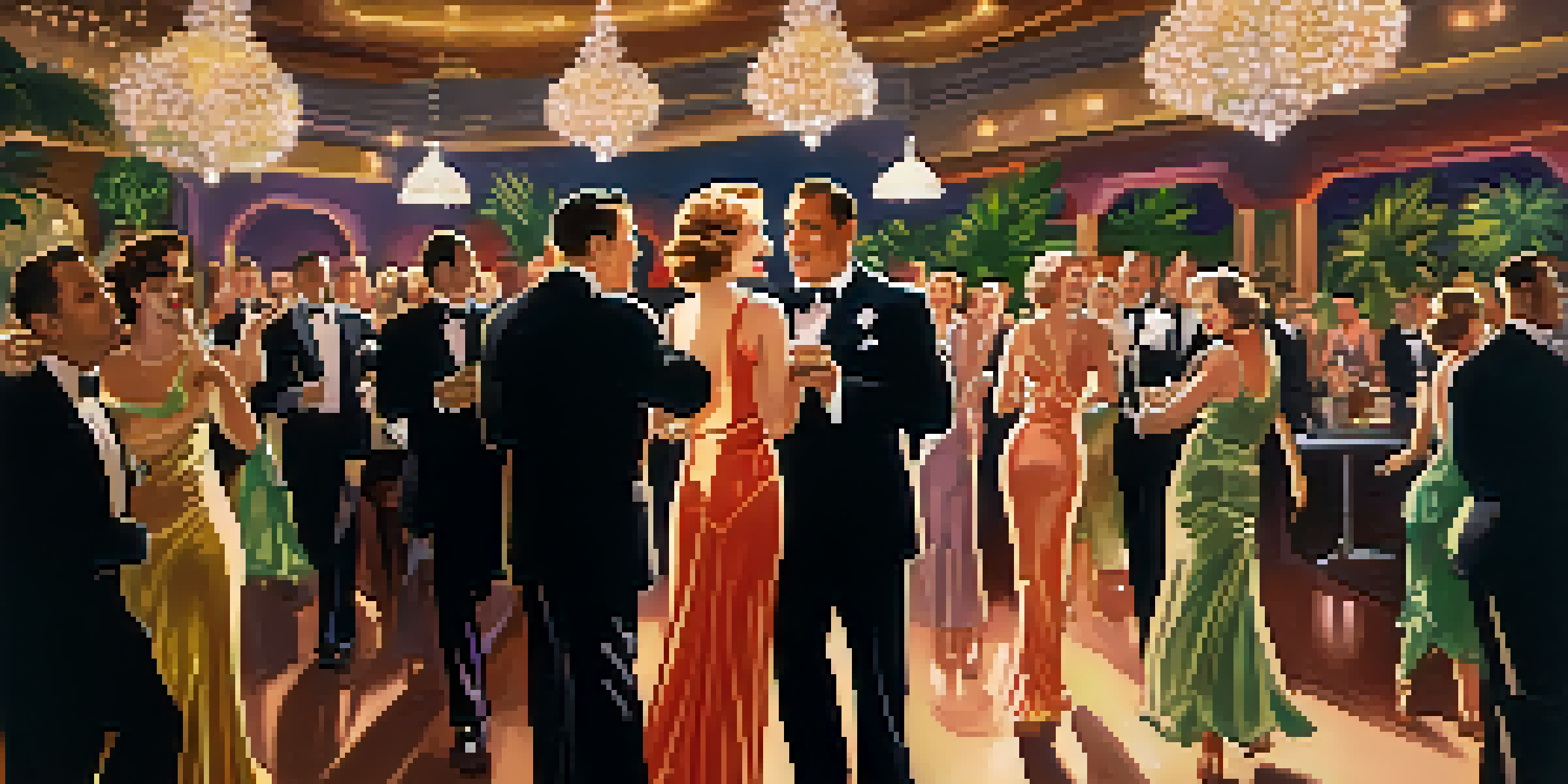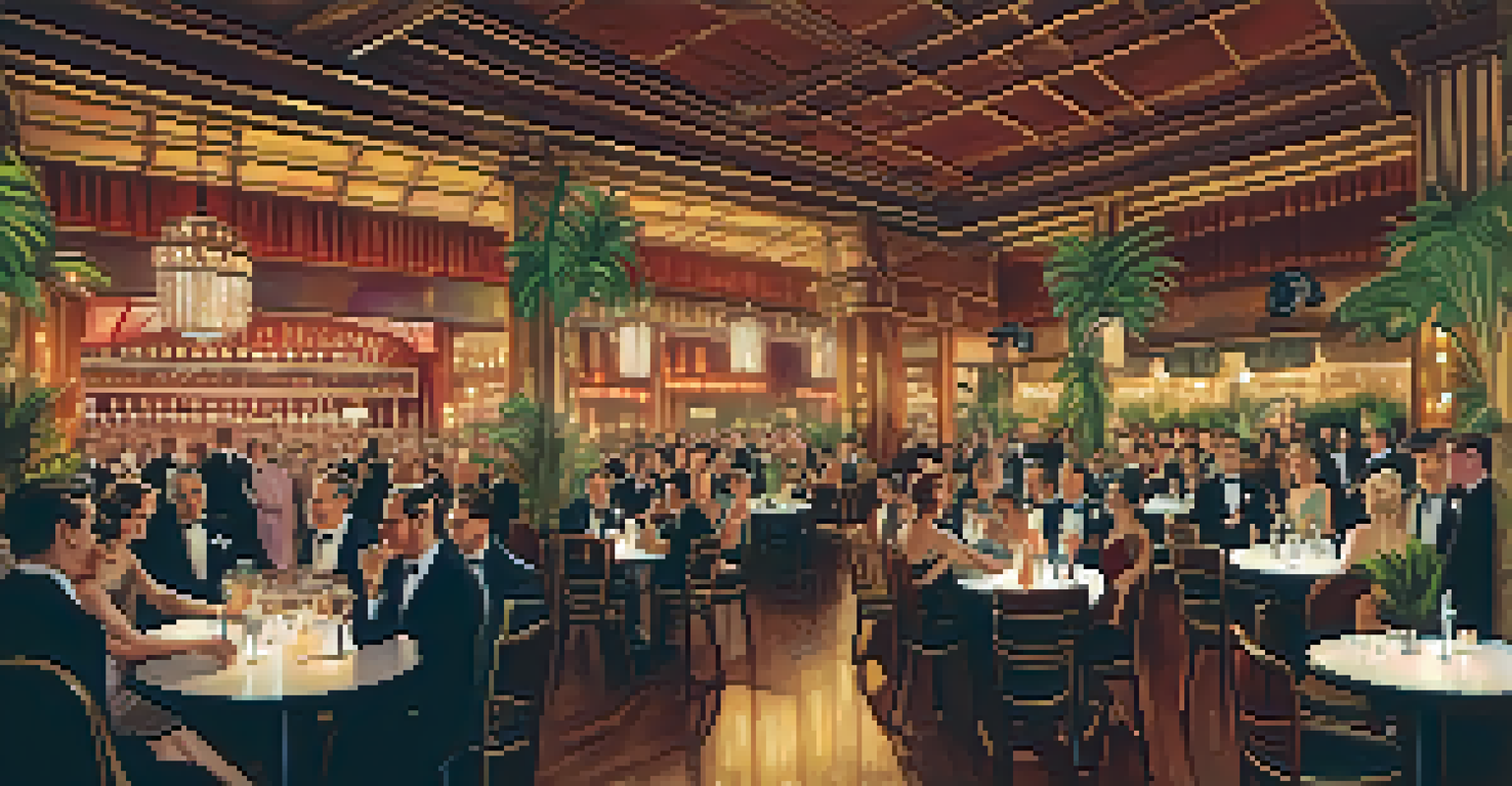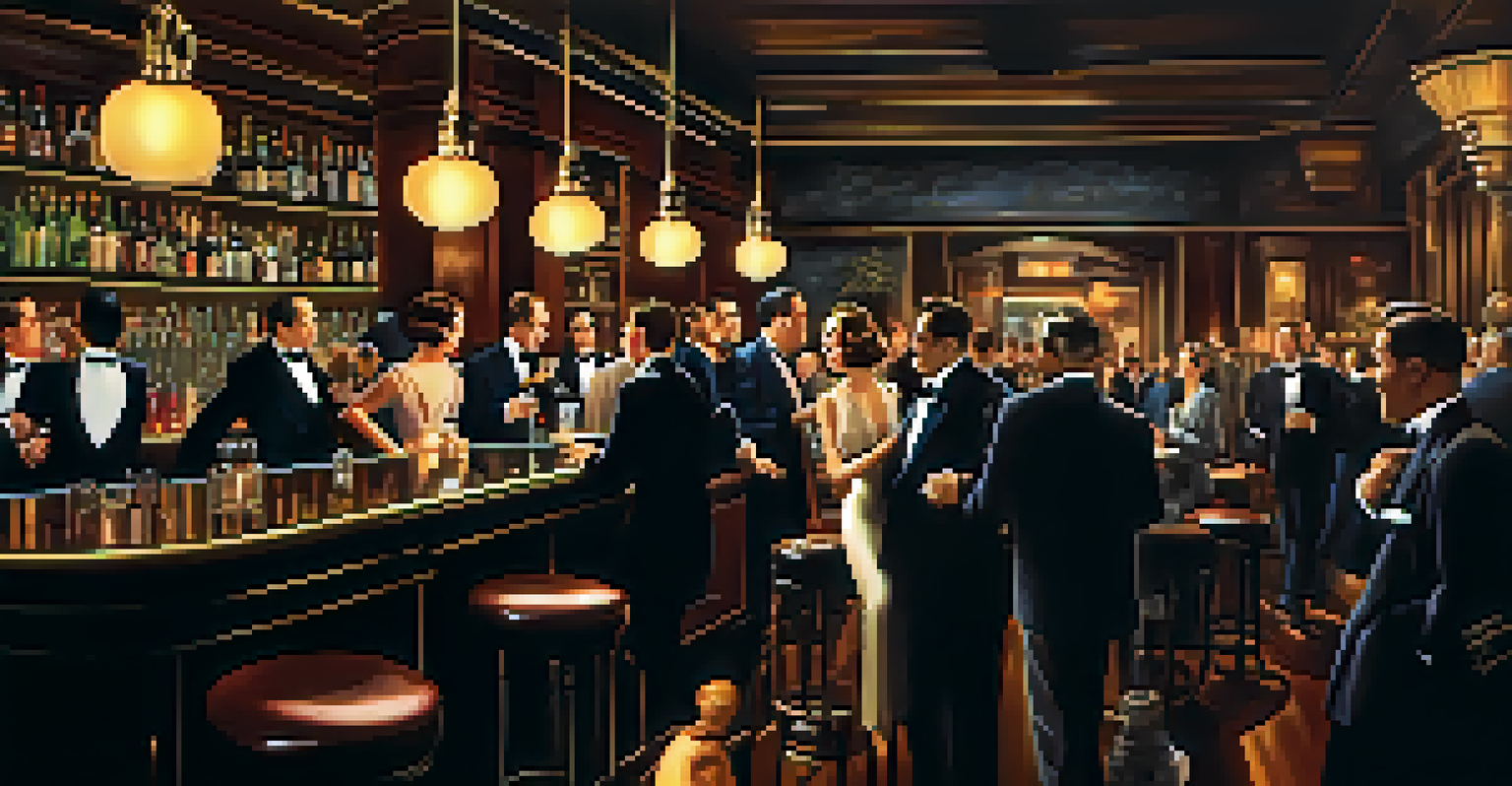Hollywood's Glamorous Nightclubs: The 1930s Experience

The Birth of Glamour: Nightclubs in 1930s Hollywood
The 1930s marked a golden age for Hollywood, where glamour and glitz ruled the night. Nightclubs became the heartbeat of the city, attracting both stars and dreamers alike. These venues were not just places to dance; they were a blend of theatricality and socializing, where the elite would flaunt their wealth and style.
The great thing about jazz is that there’s a lot of freedom in it. You can express yourself in ways that you wouldn’t be able to otherwise.
As jazz music thrived, nightclubs transformed into extravagant showcases for talented musicians and performers. Artists like Duke Ellington and Ella Fitzgerald graced the stages, captivating audiences with their electrifying performances. The ambiance was electric, with the sound of clinking glasses and laughter mingling with the soulful tunes.
Notably, venues like the Cocoanut Grove and the Trocadero offered more than just entertainment; they promised an escape into a world of luxury. Patrons dressed to the nines, with men in sharp suits and women adorned in glamorous gowns, creating an unforgettable atmosphere of elegance.
The Iconic Nightclubs: A Closer Look
Among the most iconic nightclubs of the era was the Cocoanut Grove, known for its lavish decor and star-studded guest list. It was the place where Hollywood's elite mingled, creating unforgettable memories amid lush tropical foliage and twinkling lights. The atmosphere pulsated with excitement, making it a must-visit destination for anyone seeking a taste of the high life.

Another notable venue was the Trocadero, famous for its sophisticated dining and lively performances. It was renowned for hosting lavish parties, where celebrities would dance the night away under the glow of chandeliers. The Trocadero set the standard for nightlife, combining elegance with a sense of adventure that was hard to resist.
Nightclubs: Glamour in the 1930s
Nightclubs in 1930s Hollywood became cultural hubs, blending music, fashion, and celebrity, creating an unforgettable nightlife experience.
These clubs were more than just nightlife hotspots; they were cultural hubs that influenced fashion, music, and social trends. They played a vital role in shaping the entertainment landscape of the time, inspiring future generations of performers and event spaces.
The Role of Jazz in Nightclub Culture
Jazz music was the soundtrack of the 1930s nightclub scene, embodying the spirit of the era. Its improvisational style and vibrant rhythms perfectly matched the energy of the venues, creating an atmosphere that was both lively and intimate. The genre not only set the mood but also attracted a diverse crowd who shared a love for this revolutionary sound.
Fashion is the armor to survive the reality of everyday life.
Clubs often showcased rising jazz stars, providing them a platform to shine. This symbiotic relationship between musicians and nightclubs propelled many artists to fame, illustrating how these venues played a crucial role in the music industry. The improvisation inherent in jazz mirrored the spontaneity of nightlife, making each performance a unique experience.
Moreover, jazz culture encouraged social interaction, breaking down barriers and inviting people from all walks of life to dance and celebrate together. This inclusivity fostered a sense of community, making nightclubs a melting pot of creativity and expression.
Fashion Trends: Style at the Nightclubs
The 1930s nightlife was as much about fashion as it was about music. Attendees dressed to impress, with men donning tailored suits and women opting for elegant, flowing gowns that exuded sophistication. This era marked a shift towards more glamorous styles, setting the stage for what would become an iconic fashion legacy.
Accessories played a significant role in completing the look, with pearls, fedoras, and feather boas being popular choices. The focus on appearance extended beyond clothing; makeup trends like bold lips and defined brows transformed the way women presented themselves, embodying the glamorous spirit of the time.
Jazz: The Heartbeat of Nightlife
Jazz music defined the nightclub scene, attracting diverse crowds and fostering a sense of community through its improvisational and vibrant nature.
Fashion was a statement, and nightclubs provided the perfect backdrop for showcasing these trends. The dazzling outfits not only highlighted personal style but also reflected the cultural zeitgeist of 1930s Hollywood, where every evening was an opportunity to shine.
Celebrity Sightings: Star Power in Nightclubs
The allure of Hollywood's nightclubs was magnified by the presence of its biggest stars. Celebrities like Marilyn Monroe and Frank Sinatra were often spotted enjoying the nightlife, adding an extra layer of excitement for patrons. The thrill of potentially bumping into a beloved star made a night out even more enticing.
These celebrity sightings fueled the allure of the clubs, as fans and admirers flocked to catch a glimpse of their idols. It was common for people to dress up and attend these venues in hopes of being part of the glamorous world they admired on screen. The blend of celebrity culture and nightlife created a unique social experience that felt larger than life.
Moreover, the interaction between stars and fans often resulted in unforgettable moments. Whether it was a spontaneous performance or a chance encounter at the bar, these interactions solidified the nightclubs' status as essential parts of Hollywood's social fabric.
The Impact of Prohibition on Nightclub Culture
Though the 18th Amendment banned alcohol, it didn't halt the nightlife scene; instead, it transformed it. Speakeasies emerged as hidden venues where patrons could enjoy drinks and entertainment without the fear of legal repercussions. The thrill of secrecy added an exciting layer to the nightclub experience during this tumultuous time.
Nightclubs adapted by offering elaborate cocktails and unique entertainment options to entice patrons. The need for discretion sparked creativity, leading to innovative drink recipes and performances that catered to a more adventurous crowd. This era solidified the notion that nightclubs were a refuge from the constraints of everyday life.
Fashion Trends of the Era
The 1930s nightlife was marked by glamorous fashion, with attendees showcasing sophisticated styles that reflected the cultural spirit of the time.
As Prohibition ended in 1933, nightclubs transitioned into legitimate establishments, but the spirit of innovation remained. The lessons learned during this period shaped the future of nightlife, creating a legacy that continues to influence modern clubs today.
The Evolution of Nightclub Entertainment
Nightclubs in the 1930s were not just about music and drinks; they were multifaceted entertainment hubs. Performances often included live bands, dance troupes, and even theatrical acts, creating a dynamic experience for patrons. This diversity ensured that there was something for everyone, making nights out exciting and unpredictable.
The integration of various art forms elevated the nightclub experience, allowing guests to enjoy a night of entertainment without needing to visit multiple venues. For instance, a single visit could feature a jazz performance followed by a comedy act, keeping the energy high and the audience engaged.

This trend toward varied entertainment paved the way for modern nightclub culture, where DJs, live bands, and themed events create a vibrant atmosphere. The legacy of the 1930s nightclubs is evident in today's nightlife, showcasing how an emphasis on diverse entertainment options can enhance the overall experience.